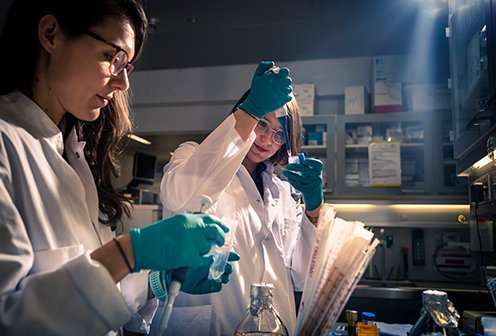Enzyme may get key role in drug design for breast cancer and brain condition

In recent years, researchers have focused on the enzyme TLK2, suspecting it of playing a main role in several diseases. A new study conducted at the University of Copenhagen now reveals that the enzyme exhibits lower levels of activity in intellectual disability and that it is possible to inhibit it in breast cancer, where it is overactive. The study thus suggests that the enzyme may be a target for potential therapies.
In order to maintain genome stability in the cells, the enzyme TLK2 constantly strives to attach phosphate to proteins. It activates specific functions in the cell and helps to stabilise the cell nucleus, which is of critical importance.
In recent years, the enzyme has been linked to various diseases. For example, researchers have discovered that the gene coding for the enzyme is overexpressed in patients suffering from ER-positive breast cancer and mutated in intellectual disability, but up until now, no one has been able to outline the behaviour of the enzyme.
Now, researchers from the University of Copenhagen and Institute for Research in Biomedicine Barcelona have described the enzyme at the molecular level using X-ray crystallography. Their study, which has just been published in the scientific journal Nature Communications, suggests that the enzyme activity diminishes in patients suffering from intellectual disability. Conversely, it seems to be possible to inhibit the enzyme in patients with breast cancer, where it is overactive.
"We are outlining the structure of this important and interesting enzyme. Once we know how it is structured, it will be much easier to develop drugs targeted at the enzyme, either inhibiting or strengthening it. This study thus points directly to drug design, as it has identified some concrete mechanisms that must be taken into account," says head of the study Guillermo Montoya, Professor at the Novo Nordisk Foundation Center for Protein Research.
Specific Genetics Inhibit the Enzyme
The researchers used biochemical methods and advanced techniques within molecular biophysics to produce a so-called molecular description of the enzyme's crystal structure. This is important because it gives the researchers insight into the behaviour of the enzyme at atomic level.
They have also taken as their starting point previous studies showing that patients suffering from intellectual disability have a mutation in genes affecting the TLK2 enzyme. In this study, they show that there is a link between the genes and the enzyme, as these same genetic mutations compromise the activity of the enzyme.
In addition, they have drawn on knowledge from other studies revealing that the enzyme is overactive in so-called ER-positive breast cancer. On this basis, they have tested several so-called small molecule drugs and learned that it is possible to inhibit the activity of the enzyme in material isolated from human cells.
The researchers will now seek to learn more about how the enzyme can be targeted and either be inhibited or activated in patients with these conditions.
The study "Molecular basis of Tousled-Like Kinase 2 activation' can be read in Nature Communications.
More information: Gulnahar B. Mortuza et al, Molecular basis of Tousled-Like Kinase 2 activation, Nature Communications (2018). DOI: 10.1038/s41467-018-04941-y
Journal information: Nature Communications
Provided by University of Copenhagen



















